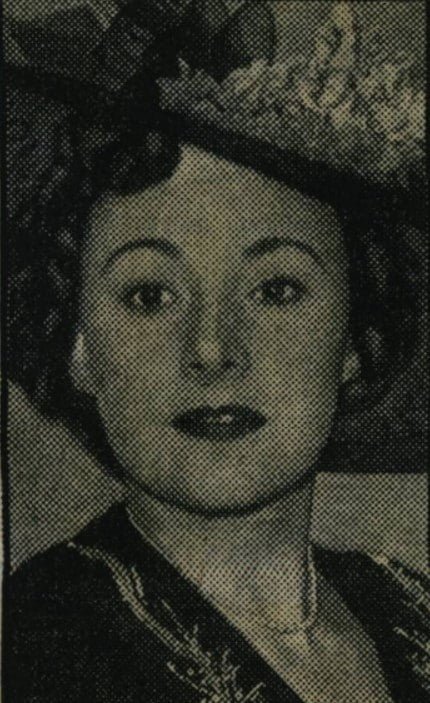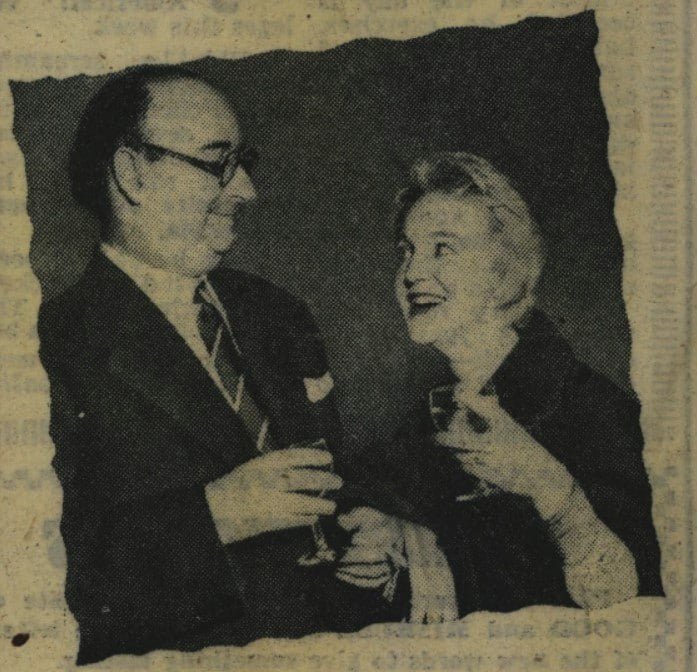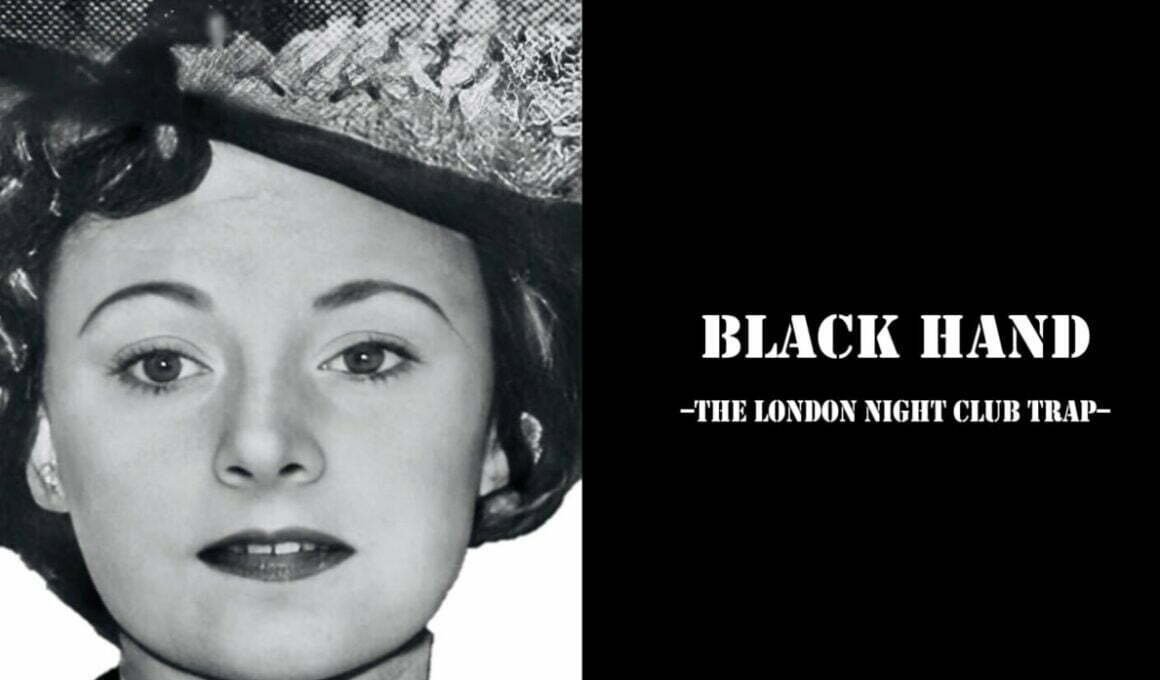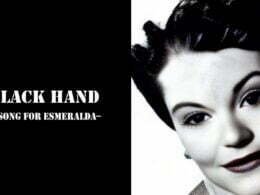In the previous instalment of this series, we examined the tragic death of Esmeralda Gullan, the founder of Esmeralda’s Barn, a night club located in an affluent part of London’s West End. However, Esmeralda was not the only female night club owner or hostess to be found dead or dying during this period. In fact, as we are about to discover, she was just one of a collection of inter-connected women who were involved in night club management and whose deaths were ruled as accidental or as suicides around the same time.
A Death on Baker Street
Barbara Knox-Marsh (sometimes written as Knox-Marshe) was born Winifred Barbara Littler on the 4 February 1928; but by the 1950s. she had started using her stage name for everything. Her mother, Margaret W. Jackson, never got the pleasure of seeing her daughter grow up as she died just a year after her birth, in 1929. Barbara had been described as an “angel” in a Daily Mirror article in 1951. On that occasion, at the tender age of 23 years-old, Knox-Marsh had reportedly backed a play called “My Wife’s Lodger” which was due to run at London’s Comedy Theatre. She paid £1000 to become a backer of the play which was deemed by all the critics as a farce and a sure loser, but soon Barbara’s picture appeared in the newspaper with the subtitle: “Barbara Knox-Marshe – girl who backed a winner.” Indeed, the stage show may have been a veritable flop when in the theatre, with one of the backers forced to sell his car to raise the funds to keep the project afloat, but the gamble eventually paid off for all the investors, as Alan Fairclough reported in his Daily Mirror piece: “This week came the little bit of heaven. The film rights of the play that everybody scoffed at have been sold.”
Barbara Knox Marsh was living the “gay life” according to an article from 17 May 1956, published in the Daily Herald. “Dancing in Mayfair… music at midnight… drinks at dawn. The day was not long enough for Barbara Knox Marsh,” read the reports. The establishment in Mayfair’s Berkeley Street, where Barbara spent the majority of her time, had originally opened in November 1954 under the name “The Stratton Club.” By May 1955, the club had begun to get a bad reputation after it was found to be “selling intoxicating liquor during other than permitted hours, and for selling without a licence” as the Westminster & Pimlico News reported on 27 May 1955. The owners were given a summons to “show cause why the club should not be struck off” with the case being adjourned for six months. By December 1955, the owners had failed to show cause and the club was officially struck-off and removed from the official register of businesses.
Yet, the club didn’t actually close and, the following April, Chief Inspector Edmund King went to the premises, supposedly to return property, only to find it openly doing business and being run as the “Blue Angel Club”. He described people dancing and drinking at the bar when he arrived and soon the club’s manager, Cyril Phillips, along with two other men were hauled in front of a judge and fined £10 for their offences. Even though there was no mention of Barbara Knox-Marsh in relation to the Blue Angel in the April 1956 Sevenoaks Chronicle and Kentish Advertiser article, which reported the court case, she was named as the owner of the establishment in multiple reports the following month. Unfortunately for Barbara Knox-Marsh, those articles reported the news of her death.

Like Esme Gullan, Barbara Knox-Marsh was found dying in her flat on Baker Street, only to be pronounced dead later at St Mary’s Hospital in Paddington. At first, her death was attributed to an overdose of sleeping pills, but this initial theory quickly changed, and soon became a very peculiar story of bizarre and unlikely happenstance. A Daily Mirror piece published on Monday 14 May 1956 reported that the police had discovered Miss Knox-Marsh’s unconscious body on the Saturday before the article went to print. They had been summoned to her residence by what the article calls “a man friend” of Knox-Marsh. She was found sitting in a chair dressed in a black evening gown and nearby was a bottle which contained sleeping tablets which the detectives quickly bagged-up as evidence.
The suspicious and untimely death of Barbara seemed like an open and shut case to the investigators in charge. This was mainly due to rumours of her apparent previous suicide attempt, even though her aforementioned aunt, Mrs. Noreen Lewis, who was by then living in Muswell Hill, told the coroner at her inquest that: “I do not think she would ever attempt to take her own life. She loved life too much.” Although she had made that statement, Mrs Lewis went on to tell the coroner that: “She was a girl inclined to dramatise. I am sure she did it thinking someone would come at the last minute to save her.” The coroner, Mr. W. Bentley Purchase, stated clearly: “There is no evidence before me to justify a verdict of suicide.” He eventually recorded a verdict of accidental death, but the actual circumstances surrounding Knox-Marsh’s death were frankly ridiculous.
Just before Knox-Marsh died, the Blue Angel had reportedly been under negotiations for a change in ownership. She had been staying with an accountant named James McBurnie during the weeks leading up to her tragic death. She had been lodging at his flat, even though Barbara also had her own flat in Southwold Mansions in Maida Vale. McBurnie told the St. Pancras coroner that he had gone to bed at around 11pm on the night of her death and woke up around 5am to discover her on the sitting-room floor with a “standard lamp lying near by”, to quote a Leicester Evening Mail article from 16 May 1956. This latter description of how her body was found also contradicts the initial reports of how her body had been discovered seated in a chair. Dr. F. E. Camps, a pathologist giving evidence to the coroner, stated that he had found about “10 grains of Seconal” in her body which he recorded as being a high dose, “but not necessarily a lethal one on ordinary circumstances.”
A Marylebone Mercury article on 18 May 1956 also noted: “She [Barbara Knox-Marsh] had been friendly with Esme Noel-Smith [i.e. Esme Gullan], Knightsbridge club owner found gassed last year, and also Linda Justice, club hostess who died from too many sleeping tablets on May 5.” A week after the latter Marylebone Mercury article, the same publication produced a fuller account of how Barbara Knox-Marsh had eventually met her tragic end.
On Friday 25 May 1956, the paper reported that: “Pathologist Dr. F. E. Camps said she had had bruises in keeping with striking something. She had marks on her wrist and neck where she had become entangled with the cord of the fallen lamp standard. These had given her respiratory embarrassment which might have contributed to her death; the main cause of which had been an overdose of Seconal. She had taken 10 grains which was a high dose, but not necessarily a lethal one.”
The coroner asked Mr. Camps: “It is not a large dose?” to which the pathologist stated: “No.” He also stated that there was nothing to suggest violence at all, seemingly ignoring his own evidence of “bruises in keeping with striking something,” and “marks on her wrists and neck.” Instead, Camps posited that Knox-Marsh had come back to the flat, taken sleeping tablets, fallen down, where the cord for the standard lamp had become wrapped around her neck. He admitted that the lamp cord had by no means asphyxiated her, and he also gave evidence stating that the overdose hadn’t been enough to kill her. Despite that, he concluded that the combination of the two had led to Knox-Marsh’s supposedly accidental death. The coroner stated his conclusion: “She might have slipped from the chair and got into an awkward position. There is no evidence to suggest suicide. Life up to now had been one of excitement and pleasure rather than depression leading to suicide.”
One of the men in charge of Barbara’s Blue Angel night club during this period was named Max Setty. He was an extremely intriguing character who came from an even more intriguing family. He was from an Iraqi family of Sephardic Jews who moved to Britain when Max and his siblings were very young. He had one sister named Eva Setty and two brothers; Jack and Stanley, with the latter being of great interest. Stanley Setty had been a car dealer and money lender less than a decade before the death of Barbara Knox-Marsh. He was also known for smuggling weapons into Palestine by using cars bought on the continental European mainland. In 1949, Stanley Setty was decapitated and had his legs chopped off in a grizzly murder, with three packages containing his head, his legs, and his torso—with his hands still tied behind his back—soon thrown from a plane into the sea, but that is a story for another occasion.
Max Setty was also once a car dealer, working alongside his unfortunate brother Stanley in various garages in London; however, in 1956 Max was officially working as the catering manager at Barbara Knox-Marsh’s Blue Angel. He continued to work as a manager at the club into the 1960s. When Barbara died, Max Setty said of her: “She was always happy. She wanted to stay up all night, play the gramophone, talk to people and drink.”
Why Barbara decided to give up her interest in the Blue Angel just before her death is unclear. Despite her decision to divest, she hadn’t fallen out of favour with the London night-spot. A Daily Mirror article from Thursday 17 May 1956 reported on her last hours, stating: “Last night at the Blue Angel, where Barbara went as a member after giving up her interest, they recalled that Friday night she sat in a softly-lit alcove drinking lime and ginger ale.” It certainly didn’t seem, from eyewitness accounts of that fateful evening, that Barbara was in any way suicidal. The latter article, entitled: “Blue Angel Girl’s Last Hours” also states: “The band was playing ‘Memories Are Made Of This.’ When the music switched to ‘Are You Satisfied?’ she got up to dance. Afterwards she threw a coin in the fountain pool over which a grey-blue plaster angel stands guard, and left, with a wave and a ‘See you tomorrow’ to her friends.”
Ruth Ellis, Linda Justice, Pamela Gale and Janet Curtis-Bennett
Esme Gullan and Barbara Knox Marsh weren’t the only women who had tragically lost their lives while running elite London night clubs during this period. The infamous Ruth Ellis was managing the Little Club when she shot and killed her lover David Blakely, a crime for which she received the death penalty. A colleague of hers, Linda Justice, had been made a hostess at only seventeen years old, after Ruth Ellis introduced her to the London night club scene by employing her at The Little Club. Ellis had been managing the club for its owner Morris Conley. By 13 May 1956, Linda, who also went by the name Gladys Linda Justice, was the registered proprietor of two companies; Justice Trading Co. and Justice Toffees, companies which she had formed with the help of a television actor named Alfred “Man Mountain” Dean. Those businesses had been registered to an address at 395 Oxford Street in London, which was a block of flats where Ruth Ellis had also lived. At the age of twenty five, Linda Justice’s apparent suicide was reported in The People newspaper, with the uncredited report stating that Justice had killed herself with an overdose of sleeping pills. She was found surrounded by empty bottles, fully clothed, in her darkened bedroom.
Linda had reportedly been a “mousey-haired elementary schoolgirl” when she had left her Peckham home to work for Ruth Ellis in an effort to “pep-up life” at the Little Club in Knightsbridge. Yet, by the time she died, her childhood hopes and dreams had come to an end in many ways. Justice had taken on Ruth Ellis’ job at the Little Club after her friend and mentor had become the last woman to be hanged in Britain around ten months before. Then, Justice had got herself into debt with creditors who were hounding her for the money she owed. She was also said to have been trapped into an abusive relationship. In an article dated 6 May 1956, a friend of Justice is quoted as saying: “She had been very depressed and drinking heavily. She had a violent row with a man she loved. For a time she talked about ‘Doing a Ruth Ellis.’ Then she quietened down and found her comfort in a glass. Perhaps that brought the end.” Linda Justice was known for being eager to excite and eager for excitement herself, at least when she was at the clubs she ran. But in reality, she was secretive and kept her personal address and phone number out of the official directories.

When Justice was approaching the end of her life, she was notably less happy and had developed a heavy drinking problem. Three months before her death, Justice stopped working and eventually found a place to stay with her friend, Mrs. Kathleen Rhodes, at a flat in Kensington. Near the end of her life, a man who lived opposite Justice, Mr. Harold Flavell, said: “She seemed very lonely. If you passed the place at any hour of the day you would hear gramophone records being played.”
Even though Linda Justice’s death was probably a suicide, a lot of women linked to the night clubs of London’s high society were dying in relatively quick succession. Esmeralda Noel-Smith had died in March 1955, Ruth Ellis had been hanged on 13 July 1955, Linda’s friend—an ex-show girl, Janet Curtis-Bennett—was found dead at the home she shared with her Q.C. husband four days before Justice’s body was found. A few days later, Barbara Knox Marsh was also found dead. There was something very peculiar happening on the upper-class London night club scene.
The aforementioned friend of Linda Justice, Janet Curtis-Bennett, had also reportedly died of an overdose of sleeping drugs. She was found cuddled up to her pet kitten, Tiddly-winks, and, the previous August, she had just become the second wife of a famous murder trial Q.C. [Queens Council], Derek Curtis-Bennett. Janet had formerly been a singer who had gone by the stage name Christine Lane.
The Home Office pathologist who examined Curtis-Bennett’s body was Dr. Donald Teare, whose name will come up again shortly. On Monday 14 May 1956, the Belfast Telegraph reported on the inquest verdict which examined the evidence surrounding the untimely death of Janet Curtis-Bennett, stating: “A verdict that she ‘died from barbituric poisoning, self-administered, and that she so killed herself,’ was recorded at the inquest today of Mrs. Janet Farquhar Curtis-Bennett.” The coroner, Mr. G. L. B. Thruston, said: “We have heard evidence which has been conflicting to suggest that she may not have been entirely happy, but I would like to make it quite empathic that apart from indicating the state of mind, it is not the function of this court to inquire into things of that nature.” A few months later, her husband was also found dead with another inquest verdict stating that: “Mr. Frederick Henry (Derek) Curtis-Bennett, Q.C., died of alcoholism was recorded at the Hammersmith, London, inquest today.” Again, Mr. G. L. B. Thruston was the coroner and Dr. Donald Teare acted as the pathologist.

The Night Club Trap
It is certainly odd that Barbara Knox-Marsh, Ruth Ellis, Esmeralda Gullan, Linda Justice and Janet Curtis-Bennett all died during this same, brief period. However, the body count in London’s night club scene during this time was higher still, as other night club girls died under tragic circumstances. On 18 September 1956, it was reported that another night club hostess had been found dead in a gas-filled flat. Pamela Gale’s dead body was found in her Pimlico flat in St. George’s Square and, in this case, two letters were found by her corpse, one of which was addressed to her father who was described in a Daily Herald article as an “Admiralty messenger.”
Police were at odds when it came to solving the death of Pamela Gale as she was again described in news reports as being a “gay, happy girl” with a friend of hers being quoted as saying: “Her only interest was to get as much out of life as possible. She lived for the pleasure that sort of life could give. She was very happy.” Pamela was described in the aforementioned article as: “Dancing till dawn as a hostess in West End drinking clubs,” with one unnamed friend being quoted as saying: “She was the gayest of us all.”

An inquest heard that Pamela had apparently made sure that her two pet budgies had not died with her, with the birds being found in the kitchen by the man who had reportedly tried to save her. Hiroyoshi Matsuda, described as an American citizen, had told the inquest that he had known the 23 year-old night club hostess for about two months and had being staying with her in her flat. Intriguingly, Matsuda suggests that another unnamed person was with them and stated: “Three of us spent Sunday afternoon drinking,” going on to say: “I thought the gin was getting hold of me and went to bed. It was about 6pm. Round about 11pm I woke up and thought I smelled gas. The living-room door was locked so I climbed through the window, along a drainpipe, and broke into the living-room through the window.” Matsuda went on to tell the inquest: “Miss Gale was laying on the floor.”
The police were called and the officer who arrived on the scene, Police Inspector Adams, found Gale’s body next to an almost empty pint bottle of gin, alongside two notes, one of which was addressed to “My dear father” while the other was addressed to “Penny”. A further article, which was published in the Westminster & Pimlico News on 21 September 1956, described Gale as someone who suffered from mood-swings and depression. The coroner recorded a verdict that Gale had died from carbon monoxide poisoning and that the two notes had shown that Gale had intended to end her own life.
A couple of days after the inquest into Pamela Gale had ruled her death to be a suicide, an article in The People newspaper, entitled: “The Night Club Trap”, painted a night club hostess’s job as a picture of debauchery and desperation. The piece, written by Charles Manifold, claimed that four out of five night clubs in London paid their hostesses nothing at all and that the girls were supposed to earn their livings on tips from customers alone. Manifold claims in this supposed expose that: “There are from 10 to 20 of these girls, chosen by management for their good looks and their easy way with men,” with the author going on to state that they are: “chosen because in conversation they have disclosed that they have a light-hearted view on virtue.”
Alongside the article were pictures of three girls with an accompanying narrative which stated: “All three of these night-club hostesses met sordid ends. Pamela Gale, Helen Carlin and Esme Noel Smith. Now read about their lives.” But there was no prior suggestion that Esmeralda Gullan (who also went by her married name Noel-Smith) was living a sordid life, or that she was a simple night club hostess, a fact which did not seem important to Mr. Manifold’s agenda.
The previously mentioned Helen Carlin, who was also referred to as “Red Helen” Carlin, seems to have been included by Manifold to spice up his articles narrative of debauchery. However, Helen Carlin was a known prostitute who had been murdered in 1954 by strangulation with her own stockings. It was believed that Carlin was murdered by a serial killer named Peter Manuel who admitted killing Carlin just before he was hanged for seven other murders to which he’d already confessed his guilt. Helen Carlin is not noted anywhere as having been a night club hostess.
Prelude to a Gangland Takeover
This string of suspicious tragedies were all to be categorised as accidental deaths or suicides and many required significant evidence to be overlooked or misinterpreted for such verdicts to be reached. But what was about to happen within the associated night clubs suggested that some very sinister people were aggressively taking control of these establishments.
Esme Gullan had apparently died by accidental gassing due to blowback putting out the flame of her gas fire, but in reality there had been a “leak” in the tube which led from the gas tank to the fire and the flame had still been lit when her body was discovered. She had also moved bedrooms without any apparent explanation as to how or why. Barbara Knox-Marsh had fallen after taking a non-lethal overdose and gently strangled herself, even though neither of those events could have killed her. As noted above, Knox-Marsh had supposedly become awkwardly wrapped up in a standard lamp cord after falling, yet the inquest evidence repeatedly stated that her dead body had been found seated in a chair. Ruth Ellis, Pamela Gale, Linda Justice, and Janet Curtis-Bennett had all died in tragic circumstances and each of those cases had left a slew of unanswered questions. With a litany of suspicious deaths as a backdrop, things in the London night club scene would only get stranger.
In the next article in this series, we will meet some of the most peculiar characters so far, two of those being Horace “Hod” Dibben and his teenage ward, Patsy Morgan-Dibben. While Esmeralda Gullan, Barbara Knox-Marsh, Linda Justice, Pamela Gale, Janet Curtis-Bennett and Ruth Ellis were all dying in quick succession, Patsy and Horace were taking charge of Esmeralda’s Barn and opening Esme’s old night club to the London underworld. Horace Dibben, a self-proclaimed Satanist who regularly organised elite sex parties for the rich and famous, was about to lose everything, as his ward, Patsy Morgan-Dibben, was reportedly taken by “the devil himself.” Was she just another girl lost to the deadly night club trap?







